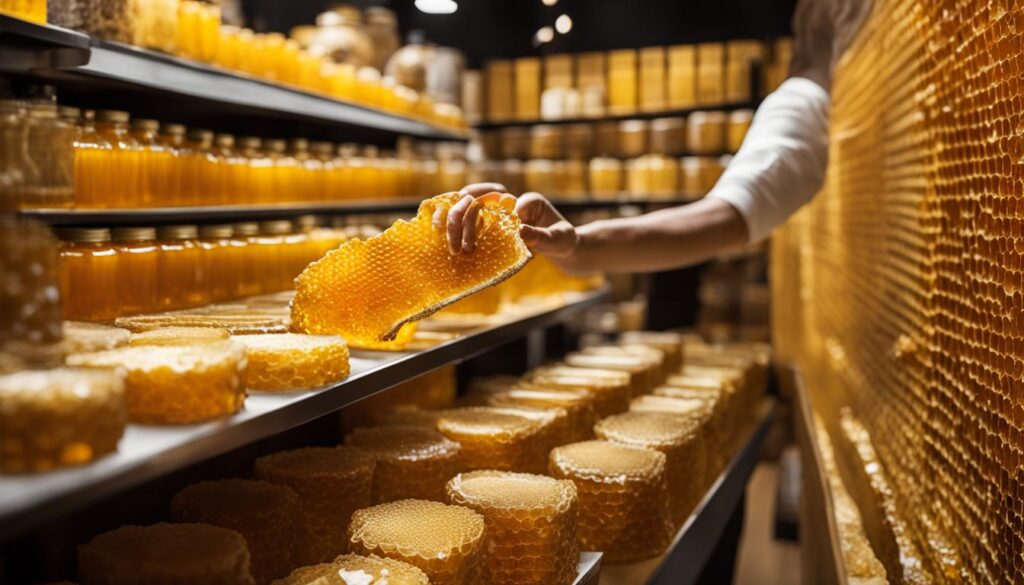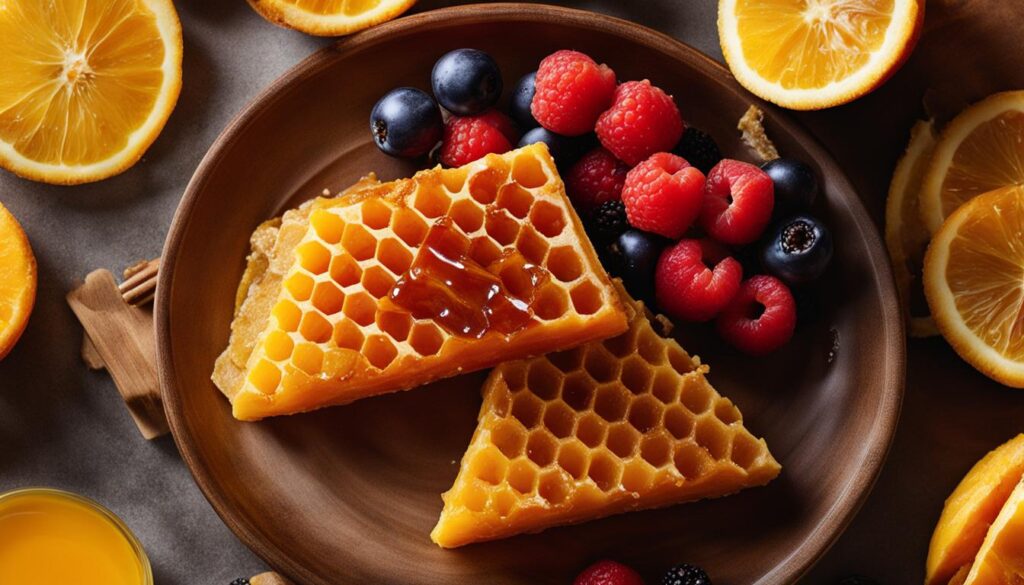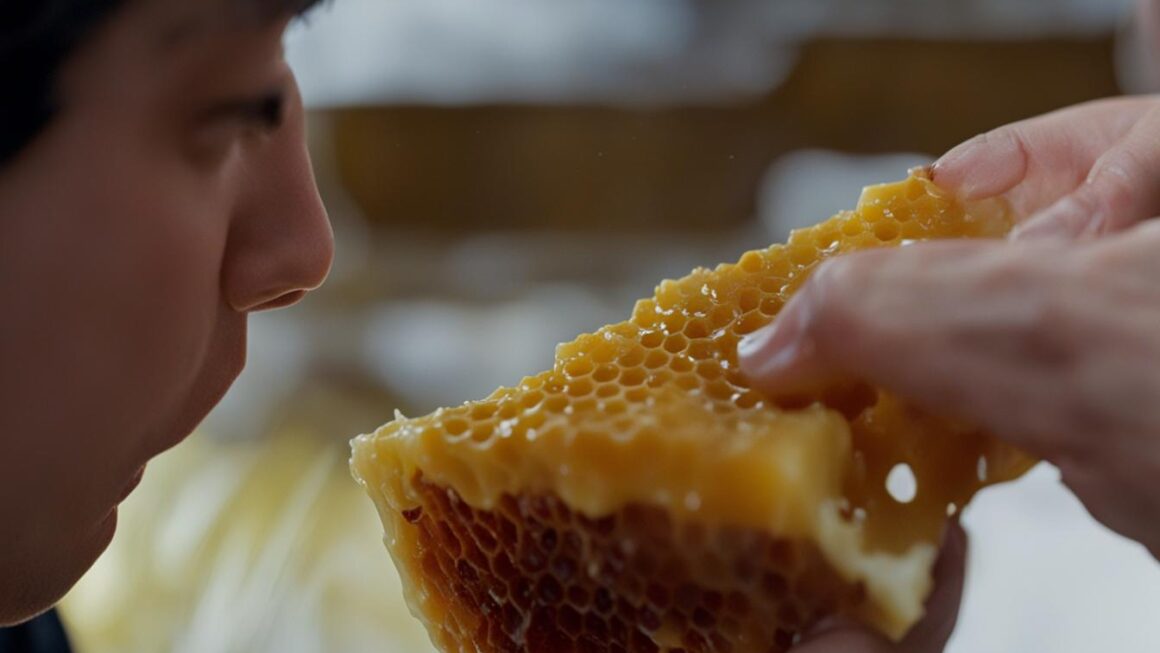Honeycomb is a delicacy that offers a unique blend of sweet honey and waxy hexagonal containers. But is it safe to eat the wax on honeycomb? Let’s find out!
Firstly, it’s important to note that honeycomb is edible, including the wax. The taste of honeycomb can vary depending on the environment and the flowers the bees pollinated. Whether you choose to enjoy it on its own or paired with cheese, chocolate, or toast, honeycomb offers a delightful culinary experience.
Honeycomb has been shown to have health benefits as well. It contributes to higher metabolisms and may even help reduce bad cholesterol. However, it’s worth noting that honeycomb is considered an animal product, which means it may not be considered vegan by some.
Key Takeaways:
- Honeycomb, including the wax, is safe and edible.
- The taste of honeycomb varies based on the environment and flower sources.
- Honeycomb is not considered vegan due to its animal product status.
- It offers health benefits such as boosting metabolism and reducing bad cholesterol.
- Honeycomb can be enjoyed in various ways, from pairing it with cheese or chocolate to spreading it on toast.
Honeycomb Composition and Nutrients
Honeycomb is a delectable combination of beeswax and raw honey. The beeswax, which forms the hexagonal structure of the honeycomb, is 100% edible. It adds texture to the honeycomb and contributes to its overall composition. On the other hand, raw honey, which makes up the majority of honeycomb, is a treasure trove of nutrients. It contains enzymes, vitamins, minerals, and antioxidants that offer various health benefits.
The beeswax in honeycomb is rich in heart-healthy long-chain fatty acids and alcohols that may help lower cholesterol levels. It provides a natural protection for the honey and creates a stable environment for the bees to store their precious honey. Raw honey, on the other hand, contains small amounts of bee pollen, propolis, and royal jelly, which further enhance its nutritional value.
Raw honey has been revered for its antimicrobial and antibacterial properties, which are diminished in processed honey. The antioxidants found in honeycomb, especially the polyphenols, can promote overall health, reduce inflammation, and protect against diseases such as diabetes, dementia, heart disease, and certain types of cancer. Consuming honeycomb can also contribute to heart health by increasing blood flow, raising “good” HDL cholesterol levels, and lowering blood pressure, triglycerides, and “bad” LDL cholesterol.
Raw honeycomb provides the most health benefits compared to other forms of honey. The enzymes, vitamins, minerals, and antioxidants present in raw honey are retained in the honeycomb, making it an ideal choice for individuals seeking the full range of honey’s nutritional benefits.
| Honeycomb Nutrients | Health Benefits |
|---|---|
| Beeswax | Heart-healthy long-chain fatty acids and alcohols that may help lower cholesterol levels |
| Raw Honey | Enzymes, vitamins, minerals, antioxidants, bee pollen, propolis, and royal jelly; antimicrobial and antibacterial properties; reduced risk of diabetes, dementia, heart disease, and certain types of cancer; improved heart health |
Overall, honeycomb offers a nutritious and delicious addition to any diet. Its unique combination of beeswax and raw honey provides a range of health benefits, while its natural composition adds texture and flavor to culinary creations. Whether enjoyed on its own or paired with other foods, honeycomb is a delightful treat that can be enjoyed by all.
Health Benefits of Honeycomb
Honeycomb offers a multitude of health benefits, making it more than just a delicious treat. The combination of raw honey and beeswax in honeycomb provides a range of nutrients and bioactive compounds that promote overall well-being. Here are some of the key health benefits associated with consuming honeycomb:
1. Antioxidant-rich:
Honeycomb is packed with antioxidants, including polyphenols, which help protect the body against oxidative stress and inflammation. These antioxidants have been linked to a reduced risk of chronic diseases, such as diabetes, heart disease, and certain types of cancer.
2. Heart-healthy:
Honeycomb has been shown to have positive effects on heart health. It can increase blood flow, raise levels of “good” HDL cholesterol, and lower blood pressure, triglycerides, and “bad” LDL cholesterol. These effects contribute to a healthier cardiovascular system and may reduce the risk of heart disease.
3. Immune system support:
The bioactive compounds present in honeycomb, such as propolis and royal jelly, have antimicrobial properties that can help strengthen the immune system. Regular consumption of honeycomb may enhance the body’s defense against certain fungi and disease-causing bacteria.
4. Cough relief:
Honeycomb, abundant in honey, has natural soothing properties that can help alleviate coughing, particularly in children. Its sticky consistency coats the throat, providing relief from irritation and reducing the frequency and intensity of coughing spells.
These are just a few of the many health benefits that honeycomb has to offer. Incorporating honeycomb into your diet can be a flavorful way to enhance your overall well-being. However, it’s important to keep in mind that moderation is key, and individuals with specific dietary concerns or allergies should consult their healthcare professionals.
| Health Benefits of Honeycomb | Description |
|---|---|
| Antioxidant-rich | Honeycomb contains polyphenols and other antioxidants that protect against oxidative stress and inflammation, reducing the risk of chronic diseases. |
| Heart-healthy | Regular consumption of honeycomb can improve heart health by increasing blood flow, raising “good” HDL cholesterol, and lowering blood pressure and triglyceride levels. |
| Immune system support | The bioactive compounds found in honeycomb, such as propolis and royal jelly, have antimicrobial properties that boost the immune system’s defenses. |
| Cough relief | Honeycomb’s natural soothing properties, especially in honey, can help alleviate coughing, providing relief from throat irritation. |
Ways to Consume Honeycomb
Honeycomb offers a range of delightful options for consumption. Whether you prefer a simple snack or want to incorporate honeycomb into your favorite dishes, there are plenty of ways to enjoy this sweet delicacy. Here are some popular ways to consume honeycomb:
- Eating it by the spoonful: Many people enjoy the unique texture and sweetness of honeycomb as a standalone snack. Simply take a spoonful and savor the natural flavors.
- Spreading it on toast or warm bread: Honeycomb can be spread on toast, English muffins, or any warm bread for a delicious and crunchy addition to your breakfast or snack.
- Pairing it with cheese or cured meat: Honeycomb pairs exceptionally well with sharp cheeses or cured meats. Serve it on crackers or as part of a charcuterie board for a delightful combination of flavors and textures.
- Using it as a topping: Add honeycomb as a topping for parfaits, yogurt bowls, or desserts. Its distinct texture and sweetness provide a unique twist to your favorite treats.
These are just a few examples of how you can enjoy honeycomb. Let your creativity guide you and experiment with different combinations to find your favorite way to consume this delectable treat.
When incorporating honeycomb into your diet, it’s essential to consider its vegan status. While honey is derived from bees and therefore not considered vegan, opinions vary on whether honeycomb is suitable for a vegan diet. Most vegans choose to avoid honeycomb due to its animal product origins. If you follow a vegan lifestyle, it’s recommended to explore alternative sweeteners that align with your dietary choices.
Buying and Storing Honeycomb
When it comes to purchasing honeycomb, there are a few options available. You can find it at local health food stores, farmers markets, or even purchase it online. It’s important to choose honeycomb made from darker honey, as it tends to have richer beneficial compounds, such as antioxidants.
When you bring home your honeycomb, storing it properly is key to maintaining its quality. Honeycomb can be stored at room temperature for extended periods of time. Over time, it may crystallize, but don’t worry, it remains edible in its crystallized form.
To ensure the longevity of your honeycomb, store it in an airtight container or wrap it tightly in plastic wrap. This will help prevent any moisture or contaminants from affecting the honeycomb. By following these simple storage tips, you can enjoy the deliciousness of honeycomb for weeks or even months!
| Storage Tips for Honeycomb |
|---|
| Store honeycomb at room temperature |
| Keep honeycomb in an airtight container |
| Wrap honeycomb tightly in plastic wrap |
With these guidelines in mind, you can confidently purchase and store honeycomb, ensuring that it remains fresh and ready to be enjoyed whenever you desire.

Safety Considerations with Honeycomb
Honeycomb is generally considered safe to eat, but it’s important to be aware of a few safety considerations. One potential concern is the risk of contamination with C. botulinum spores, which can be harmful, especially for pregnant women and children under 12 months of age. It’s advisable to avoid giving honey or honeycomb to infants to reduce the risk of infant botulism. Additionally, consuming large amounts of honeycomb may potentially cause stomach obstructions, so it’s best to enjoy it in moderation.
Individuals with allergies to bee venom or pollen should exercise caution when consuming honeycomb, as it may trigger an allergic reaction. It’s always recommended to consult with a healthcare professional if you have any concerns or known allergies.
Proper storage and handling of honeycomb are also crucial to maintain its safety. While honeycomb does not have an expiration date, it is important to store it properly in a cool, dry place to prevent spoilage or mold growth. When stored correctly, honeycomb can be enjoyed for an extended period.
Key Safety Considerations with Honeycomb:
- Avoid giving honey or honeycomb to infants under 12 months to reduce the risk of infant botulism.
- Consume honeycomb in moderation to avoid potential stomach obstructions.
- Exercise caution if you have allergies to bee venom or pollen.
- Properly store honeycomb in a cool, dry place to maintain its safety.
The Benefits of Eating Raw Honeycomb
Eating raw honeycomb provides numerous benefits due to its unique composition and rich nutritional value. Raw honeycomb contains the highest concentration of enzymes, vitamins, minerals, and antioxidants compared to other forms of honey. The raw honey within the honeycomb retains its antimicrobial and antibacterial properties, making it a powerhouse for supporting overall health.
One of the advantages of consuming raw honeycomb is its high level of antioxidants. These compounds have been shown to promote general well-being, reduce inflammation, and protect against various diseases. The polyphenols found in honeycomb may help lower the risk of diabetes, dementia, heart disease, and certain types of cancer.
Honeycomb also plays a role in supporting heart health. It can increase blood flow, raise levels of the “good” HDL cholesterol, and reduce blood pressure, triglycerides, and “bad” LDL cholesterol. Additionally, the consumption of honeycomb can strengthen the body’s defenses against certain fungi and disease-causing bacteria.
Incorporating honeycomb into your diet may be beneficial for individuals with diabetes, as it can serve as a sugar alternative. Honeycomb is sweeter than refined sugar, so smaller quantities are needed to achieve the desired level of sweetness. Moreover, honeycomb raises blood sugar levels less than processed sugar, making it a potentially better option for those managing their blood glucose levels.
The Nutritional Value of Raw Honeycomb
| Nutrient | Amount per serving (1 oz) |
|---|---|
| Calories | 96 |
| Carbohydrates | 25 grams |
| Fiber | 0 grams |
| Fat | 0 grams |
| Protein | 0 grams |
| Vitamin C | 0% |
| Calcium | 0% |
| Iron | 0% |
Note: Nutritional values may vary depending on the source and quality of the honeycomb.
“Eating raw honeycomb allows individuals to enjoy the full benefits of honey in its purest form.”
In summary, consuming raw honeycomb can be a delicious and nutritious addition to your diet. Its high levels of enzymes, vitamins, minerals, and antioxidants provide numerous health benefits, including supporting heart health, boosting the immune system, and aiding liver function. Remember to enjoy honeycomb in moderation and consider it as a potential alternative to refined sugar, particularly for individuals managing diabetes.
Honeycomb and its Role in Traditional Beekeeping
Honeycomb has played a significant role in traditional beekeeping practices for centuries. It serves as a vital structure for storing honey and pollen, as well as nurturing new broods of bees. The hexagonal shape of honeycomb is a marvel of nature, providing a flexible and strong structure that maximizes storage space while minimizing material usage. This natural design can be observed not only in the beekeeping world but also in various other aspects of nature, from plant stems to bones.
In ancient times, honeycomb and its production were highly valued. The harvesting of honeycomb was an important task that required expertise and careful handling. Beekeepers would carefully remove the honeycomb from beehives, ensuring minimal disruption to the bees and the overall structure of the combs. The honeycomb would then be carefully extracted to obtain the honey and wax, preserving the integrity of the hexagonal cells.
Honeycomb in traditional beekeeping continues to be an essential element in maintaining healthy bee colonies and ensuring the production of high-quality honey. It provides bees with a secure and organized space for storing honey, pollen, and raising new generations of bees. The structure of honeycomb allows for efficient food storage, protection against external elements, and optimal use of available space within the hive.
“The hexagonal shape of honeycomb is a marvel of nature, providing a flexible and strong structure that maximizes storage space while minimizing material usage.”
The Significance of Honeycomb in Traditional Beekeeping
The use of honeycomb in traditional beekeeping not only benefits the bees but also plays a crucial role in sustaining local ecosystems. Honeycomb provides a stable and safe environment for bees to thrive, ensuring the pollination of plants, the production of honey, and the overall balance of nature. The careful management of honeycomb in traditional beekeeping practices showcases the profound connection between humans and bees, highlighting the importance of preserving and respecting these incredible creatures.
| Benefits of Honeycomb in Traditional Beekeeping | Ancient Practices |
|---|---|
| Optimal storage space for honey and pollen | Honeycomb harvesting techniques |
| Efficient use of materials | Preservation of honeycomb integrity |
| Promotes colony health and reproduction | Role of honeycomb in sustaining ecosystems |
The legacy of honeycomb in traditional beekeeping continues to inspire and guide modern practices, emphasizing the importance of maintaining the natural structure and function of honeycombs. By understanding and appreciating honeycomb’s role in beekeeping, we can nurture and protect these remarkable insects while enjoying the sweet rewards they provide.
Honeycomb in Culinary Delights
Honeycomb adds a unique and delightful touch to a wide range of culinary creations. Its sweet and waxy texture enhances the flavors and textures of various dishes, making it a versatile ingredient to work with. Whether you’re looking for a simple snack or an elegant addition to your homemade desserts, honeycomb can be the perfect choice.
The Versatility of Honeycomb
When it comes to incorporating honeycomb into your culinary endeavors, the possibilities are endless. Here are some creative ideas to inspire your honeycomb-infused dishes:
- Spread honeycomb on warm bread, English muffins, or scones for a delectable and indulgent treat.
- Add chunks of honeycomb to your yogurt and mixed berries for a burst of sweetness and textural contrast.
- Use honeycomb as a topping for pancakes, oatmeal, or even ice cream to elevate your breakfast or dessert experience.
- Pair honeycomb with fresh fruit and aged cheeses for a sophisticated and flavorful cheese board.
- Incorporate honeycomb into homemade desserts like cakes, cookies, or tarts to infuse them with a hint of natural sweetness.

“Honeycomb in culinary delights adds a unique and delightful touch to various dishes. Its sweet and waxy texture enhances flavors and textures, making it a versatile ingredient to work with.”
Discovering New Flavors
Exploring honeycomb in your culinary endeavors allows you to discover new flavors and experiment with different taste combinations. The natural sweetness and subtle floral notes of honeycomb can complement both sweet and savory dishes, offering a delightful experience for your taste buds.
Whether you’re a professional chef or a passionate home cook, incorporating honeycomb into your recipes opens up a world of culinary possibilities. So, why not embrace the sweetness of honeycomb and embark on a gastronomic adventure that will tantalize your senses?
Experiencing the Delight of Honeycomb
If you’re unsure about trying honeycomb, you can visit a honey tasting bar or store to sample it. Honeycomb offers a unique texture and sweetness that can be experienced firsthand. Many people enjoy eating honeycomb as a snack, chewing it like gum. It provides a satisfying and delightful experience for the taste buds.
When trying honeycomb at the store, you can explore different types and flavors. Some honeycombs may have a more delicate and mild taste, while others are bold and robust. The taste can vary depending on the flowers the bees collected nectar from. Sampling honeycomb allows you to discover your preferences and find the perfect honeycomb to enjoy.
Honeycomb offers a unique texture and sweetness that can be experienced firsthand.
Sampling honeycomb is a sensory experience that goes beyond just the taste. The aroma of the honey, the smoothness of the wax, and the satisfying crunch create a multi-dimensional delight. It’s an opportunity to immerse yourself in the world of bees and appreciate their incredible craftsmanship.
So, if you’re curious about honeycomb, don’t hesitate to give it a try. Visit a local honey retailer, and let your taste buds embark on a sweet and textured adventure. You may discover a new favorite delicacy that adds a touch of natural sweetness to your culinary creations.
Honeycomb as a Sugar Alternative
Honeycomb can be considered a viable sugar alternative, especially for individuals with diabetes. Compared to refined sugar, honeycomb is sweeter, meaning smaller quantities are needed to achieve the desired level of sweetness. Additionally, honeycomb has a lower glycemic index, which means it raises blood sugar levels less compared to regular sugar. This makes it a potentially better option for individuals who need to manage their blood sugar levels effectively.
| Honeycomb | Refined Sugar |
|---|---|
| Sweeter taste | Standard sweetness |
| Lower glycemic index | Higher glycemic index |
| Rich in antioxidants and nutrients | Lacks nutritional value |
| May help reduce insulin resistance | No impact on insulin resistance |
In addition to its potential benefits for individuals with diabetes, honeycomb also contains beneficial compounds found in beeswax. These compounds may help reduce insulin resistance, which can have further positive effects on blood sugar control. However, it’s important to note that moderation is key, as honeycomb still contains natural sugars and can raise blood sugar levels if consumed in excessive amounts.
When incorporating honeycomb as a sweetener, individuals with diabetes should monitor their blood sugar levels closely and consult with a healthcare professional to determine the appropriate portion sizes and frequency of consumption.
Expert Quote:
Honeycomb can be a suitable sugar alternative for individuals with diabetes due to its lower glycemic index and potential benefits in reducing insulin resistance. However, it’s important to remember that moderation is key, and individuals should monitor their blood sugar levels closely when consuming honeycomb as a sweetener.
Conclusion
In conclusion, honeycomb is a safe and enjoyable food that can be consumed, including the edible wax. Not only is honeycomb delicious, but it also offers a range of health benefits. From promoting heart health to boosting the immune system and aiding liver function, honeycomb is a nutritious addition to any diet.
There are various ways to enjoy honeycomb, whether you prefer to eat it on its own or pair it with other foods. However, it’s important to store honeycomb properly to maintain its freshness. Additionally, consuming honeycomb in moderation is advised, particularly for those with allergies or sensitivities.
To fully experience the nutritional benefits of honeycomb, it is recommended to consume it in its raw form. Raw honeycomb contains the highest amount of enzymes, vitamins, minerals, and antioxidants, making it a superior choice compared to processed honey. Incorporating honeycomb into your diet can be a delightful and healthy choice.
FAQ
Is it safe to eat the wax on honeycomb?
Yes, honeycomb wax is edible and safe to eat.
What is the composition of honeycomb and its nutrients?
Honeycomb is made up of beeswax hexagons and raw honey, which contains enzymes, vitamins, minerals, and antioxidants.
What are the health benefits of honeycomb?
Honeycomb has been shown to contribute to higher metabolisms, reduce bad cholesterol, and provide overall health benefits such as reducing inflammation and protecting against diseases.
How can honeycomb be consumed?
Honeycomb can be enjoyed on its own or paired with other foods such as cheese or chocolate. It can also be spread on toast, used as a topping for yogurt or parfaits, or added to various dishes as a garnish.
Where can honeycomb be purchased and how should it be stored?
Honeycomb can be purchased at local health food stores, farmers markets, or online. It can be stored at room temperature for extended periods, and if crystallized, it remains edible in its crystallized form.
Are there any safety considerations with honeycomb?
While honeycomb is generally considered safe to eat, it can be contaminated with C. botulinum spores and may potentially cause stomach obstructions if consumed in large amounts. People with allergies to bee venom or pollen should also exercise caution.
What are the benefits of eating raw honeycomb?
Raw honeycomb contains the highest amount of enzymes, vitamins, minerals, and antioxidants compared to other forms of honey. It retains more nutritional value and provides antimicrobial and antibacterial properties.
What is the role of honeycomb in traditional beekeeping?
Honeycomb serves as a structure for storing honey and pollen, as well as nurturing new broods of bees. Its hexagonal shape provides a flexible and strong natural design.
How can honeycomb be used in culinary delights?
Honeycomb can be used as a spread, topping, or ingredient in various dishes such as desserts, pancakes, oatmeal, and yogurt. It can also be paired with fruit, cheese, or used as part of a charcuterie board.
How can I experience the delight of honeycomb?
You can visit a honey tasting bar or store to sample honeycomb and enjoy its unique texture and sweetness. Many people enjoy chewing honeycomb like gum for a satisfying experience.
Can honeycomb be used as a sugar alternative?
Yes, honeycomb is sweeter than sugar, meaning smaller quantities are needed for the same level of sweetness. It raises blood sugar levels less than refined sugar and may benefit individuals with diabetes.




